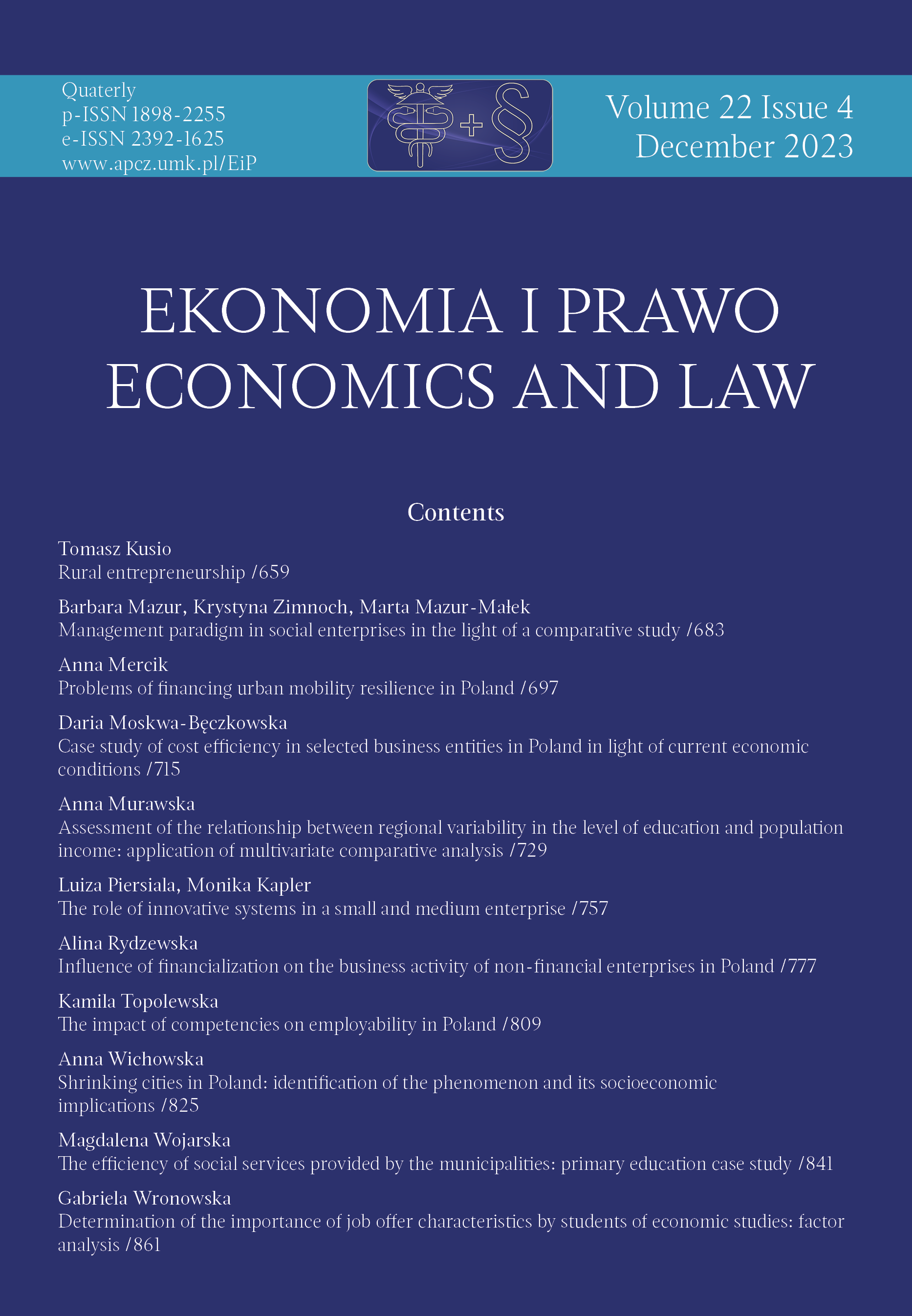Case study of cost efficiency in selected business entities in Poland in light of current economic conditions
DOI:
https://doi.org/10.12775/EiP.2023.038Keywords
costs, enterprises, effective managementAbstract
Motivation: Current economic conditions, including, but not limited to, the rising inflation rate, changes in electricity prices or changes in tax law significantly affect the manner of operation of business entities in Poland. The economic impact of these changes varies greatly depending on the type of business, industry or economic sector represented. These changes are also reflected in the level and structure of the entities’ own costs — primarily in the when considering costs by type. The multitude of changes that Polish companies now face also indicates the importance and relevance of the concept of effective cost management in these difficult economic conditions. Therefore, the need to adapt the business to the peculiarities of the new economic reality created the basis for a thorough identification of cost information needs coming in from the cost accounting systems used in companies. This became one of the prerequisites for undertaking research on evaluating the usefulness of cost accounting systems used in business entities for effective management of their costs.
Aim: The purpose of this article is to analyze and assessment the cost effectiveness of selected entities representing production, commercial and service activities in the context of recent changes in economic in Poland.
Results: The main conclusion of the analysis is that the current economic conditions have a significant impact on the level and structure of own costs in business entities. Therefore, these entities need specialized economic tools to improve the efficiency of their cost management. It is because the traditional full-cost accounting system used by most business entities in Poland is proving to be inadequate in this regard.
References
Bełch, P. (2015). Analiza kosztów rodzajowych w sektorze paliwowym. Research Papers of Wrocław University of Economics, 398, 53–61. https://doi.org/10.15611/pn.2015.398.04.
Bucior, G. (2006). Koszty normatywne zadań jako narzędzie budżetowania sektorze publicznym. In M. Nowicka-Skowron (Ed.), Koszty w zarządzaniu przedsiębiorstwem: standardy międzynarodowe (pp. 195–203).AGH.
Ciechan-Kujawa, M. (2005). Rachunek kosztów jakości: wykorzystanie w zarządzaniu przedsiębiorstwem. Oficyna Ekonomiczna.
Drucker, P. (1963). Managing for business effectiveness. Harvard Business Review, May–June, 53–60.
Farafonova, N.V. (2011). Essence and components of economic efficiency of business activities within agrarian sector. Actual Problems of Economics, 124(10), 176–185.
Harrison, J., & Rouse, P. (2016). DEA and accounting performance measurement. In S.N. Hwang, H.S. Lee, & J. Zhu (Eds.), Handbook of operations analytics using data envelopment analysis, 239, 385–412. Springer. https://doi.org/10.1007/978-1-4899-7705-2_15.
Helms, M.M. (Ed.). (2006). Encyklopedia of management. Thompson Gale.
Herath, T.N. (2008). An assessment of decentralized government school education in Sri Lanka. Kedi Journal of Educational Policy, 5(1), 19–48.
Kołodziejczuk, B. (2014). Zarządzanie kosztami w poprawie efektywności wykorzystania zasobów przedsiębiorstwa. Prace Naukowe Uniwersytetu Ekonomicznego We Wrocławiu, 335, 116–125. https://doi.org/10.15611/pn.2014.335.10.
Lockwood, B. (2008). Pareto efficiency. In S.N. Durlauf, & L.E. Blume (Eds.), The new palgrave dictionary of economics (pp. 4804–4807). Palgrave Macmillan. https://doi.org/10.1007/978-1-349-58802-2_1246.
Moskwa-Bęczkowska, D. (2019). Cost accounting in public universities in Poland and their information needs in this field: results of own survey research. In L. Gómez Chova, A. López Martínez, & I. Candel Torres (Eds.), EDULEARN19 Proceedings (pp. 1014–1022). https://doi.org/10.21125/edulearn.2019.0327.
Moskwa-Bęczkowska, D. (2021). The financial condition of selected enterprises from the Świętokrzyskie voivodeship during the COVID-19 pandemic: a survey analysis. Humanities & Social Sciences Reviews, 9(6), 46–50. https://doi.org/10.18510/hssr.2021.968.
Nadolna, B. (2016). Kategorie kosztów decyzyjnych a analiza kosztów relewantnych. Finanse, Rynki Finansowe, Ubezpieczenia, 80(2), 285–293. https://doi.org/10.18276/frfu.2016.2.80/2-30.
Novak, P., & Popesko, B. (2014). Cost variability and cost behaviour in manufacturing enterprises. Economics & Sociology, 7(4), 89–103. https://doi.org/10.14254/2071-789X.2014/7-4/6.
Onistrat, O.V. (2008). Enterprises’ advertising activity efficiency. Actual Problems of Economics, 85, 127–132.
PAiZ. (2021). Stabilność ekonomiczna i silna gospodarka. Retrieved 10.02.2023 from https://www.paih.gov.pl/wybierz_polske/stabilnosc_ekonomiczna_i_silna_gospodarka.
Popesko, B., & Novak, P. (2011). Changes in the enterprise cost structure: Czech perspective. In E. Jircikova, E. Pastuszkova, & J. Svoboda (Eds.), Finance and the performance of firms in science, education, and practice (pp. 375–380). Tomas Bata University in Zlin.
Rokita, S. (2017). Problems in measuring economic efficiency in local government units in Poland. In P. Slavickova (Ed.), Knowledge for market use 2017: people in economics: decisions, behavior and normative models (pp. 159–164). University Palackeho in Olomouci.
Rouse, P., Harrison, J., & Turner, N. (2011). Cost and performance: complements for improvement. Journal of Medical Systems, 35(5), 1063–1074. https://doi.org/10.1007/s10916-010-9520-1.
Ruimei, L., & Zhe, W. (2010). Public security, economic efficiency and social capital. In G. Yang, X. Duan, G. Cheng, H. Yao, Z. Sun, & B. Zhang (Eds.), Proceedings of the 2010 Chinese seminar on the principles of safety science and technology (pp. 51–55). Science Press USA Inc.
Seyedboveir, S., Kordrostami, S., Daneshian, B., & Amirteimoori, A. (2017). Cost efficiency measurement in data envelopment analysis with dynamic network structures: a relational model. Asia-Pacific Journal of Operational Research, 34(5), 1750023. https://doi.org/10.1142/S0217595917500233.
Skrzypek, E. (2002). Jakość i efektywność. UMCS.
Statistics Poland. (2022). Activity of non-financial enterprises in 2021. Retrieved 10.02.2023 from https://stat.gov.pl/download/gfx/portalinformacyjny/en/defaultaktualnosci/3317/1/16/1/activity_of_non-financial_enterprises_in_2021.pdf.
Wagner, J. (2012). Recognition and behavior of variable and fixed costs. Politicka Ekonomie, 60(5), 668–678. https://doi.org/10.18267/j.polek.869.
Zieliński, T. (2018). Resource and process consumption accounting (RPCA) vs. operational excellence of an enterprise. Prace naukowe Uniwersytetu Ekonomicznego we Wrocławiu, 514, 486–499. https://doi.org/10.15611/pn.2018.514.44.
Zieliński, T. (2020). Zasobowo-procesowy rachunek kosztów ZPRK/RPCA (2nd ed.). Akademia Controllingu.
Zimkova, E. (2015). Cost efficiency of Slovak commercial banks under the standpoint of the intermediation approach. In S. Hronova & K. Vltavska (Eds.), 18th Amse: applications of mathematics and statistics in economics (pp. 1824–1832). Oeconomica Publishing House.
Downloads
Published
How to Cite
Issue
Section
License
Copyright (c) 2023 Daria Moskwa-Bęczkowska

This work is licensed under a Creative Commons Attribution-NoDerivatives 4.0 International License.
Stats
Number of views and downloads: 573
Number of citations: 0
